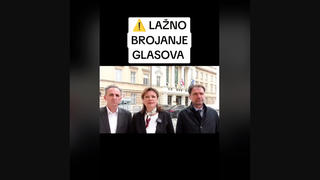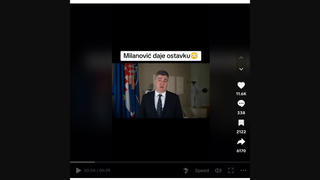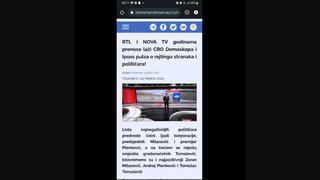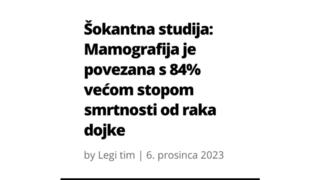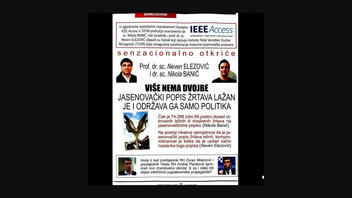
Did Zagreb University professors Neven Elezović and Nikola Banić prove in a scientific article that the list of victims of the Ustasha Jasenovac camp was fabricated? No, that's not true: Several experts told Lead Stories that Elezović and Banić used a deeply flawed and inapplicable mathematical method in their 2020 article. In addition, the two authors have been publicly promoting the Holocaust and genocide distortion and denial, while ignoring the historical context and facts.
The claim appeared in a video (archived here) on TikTok on February 5, 2024. It opened (translated from Croatian to English by Lead Stories staff):
sensational discovery
THERE IS NO PROBABILITY that the Jasenovac list of victims is true. The lesson of this work is that the official list of Jasenovac victims is deeply compromised. It is not a question of removing some names from that list that have been proven not to belong there. However, the compromise in terms of the methods of mathematical statistics is so great that it calls into question the very way that list was created. Mathematics cannot answer the questions of how this happened and what needs to be changed. This is now the task of historians.
NO MORE DOUBT
THE JASENOVAC LIST OF VICTIMS IS FAKE AND IS ONLY MAINTAINED BY POLITICIANS
As many as 74,288 (about 89%) false or dubious victims discovered so far are on the Jasenovac list (Nikola Banić)
There is no probability that the list of victims in Jasenovac is true, the compromise is so great that the method of creation of that list is questionable (Neven Elezović)
This is what the post looked like on TikTok at the time of writing:

(Source: TikTok screenshot taken on Thu Mar 7 19:47:52 2024 UTC)
Independent State of Croatia (NDH)
The Independent State of Croatia (archived here) (Nezavisna Država Hrvatake or NDH) was a puppet state proclaimed on April 10, 1941, with the full cooperation of Nazi Germany and Fascist Italy. During the four years of the NDH's existence, Ante Pavelić ruled under a fascist totalitarian dictatorship, called the Ustasha regime (archived here). In the NDH, between 1941 and 1945, a total of 22 concentration camps were operated. Jasenovac was the largest and operated the longest.
Jasenovac camp
Jasenovac camp (archived here) was opened in 1941 as a multipurpose camp. It was a concentration camp where men, women and children from all over the NDH were sent, primarily Serbs, Jews, Romanis and other "unacceptable" minorities. It was also a transit camp; some of the detainees were sent from it to Germany and other camps throughout occupied Europe. It also served as a labor camp, where the detainees worked for free, and a prison camp, because people were sent there by court orders. And it was a military camp, where political dissidents and opponents of the Ustasha regime were imprisoned, regardless of their race or nationality.
Jasenovac was a complex with five smaller camps (archived here): Krapje camp I, Bročice camp II, Ciglana camp III, Kožara work group (camp IV) in Jasenovac and camp V in Stara Gradiška.
Number of victims
The official data of the Jasenovac Memorial Site lists 83,145 victims by their names. Researchers of the Memorial Site estimate that between 80,000 and 100,000 people were killed there. Independent international sources roughly agree with this estimate. A figure of at least 85,000 victims is stated by the Simon Wiesenthal Center (archived here), and the United States Holocaust Memorial Museum in Washington (archived here) mentions between 77,000 and 99,000 victims.
Professor Neven Elezović, author of a mathematics textbook for children, and Nikola Banić, a programmer, both from the Faculty of Electrical Engineering and Computing of the University of Zagreb, claim to have proven that the number of victims was fabricated. They explain this in their 2020 paper "TVOR: Finding Discrete Total Variation Outliers Among Histograms" (archived here), published in the IEEE Access (archived here), an open-access, multidisciplinary, scientific journal published by the Institute of Electrical and Electronics Engineers.
Mathematical method
According to their explanation, the list of victims from the Jasenovac Memorial Site was fabricated because it contains too many people on it whose birth year ends with a zero or a two. They claim that the discrepancy is most obvious in comparison to the birth years of Auschwitz victims, where the distribution is, according to them, "smooth." The authors call this anomaly "the Jasenovac hedgehog," as the spines on the graph from their article resemble those of a hedgehog:

(Source: IEEE Access screenshot taken on Mon Mar 11 18:27:31 2024 UTC)
Jasenovac's list of victims
Lead Stories reached out to the Jasenovac Memorial Site inquiring about the 2020 paper and asking how data for the victims' list were collected. In a March 6, 2024, email to Lead Stories, senior curator Đorđe Mihovilović denied that the list was fabricated and explained how data were gathered and how discrepancies were underlined and properly signaled (translated from Croatian to English by Lead Stories staff):
I responsibly claim that our database of victims is not a fabrication because we did not invent data, but transparently downloaded it from other sources and literature, which we stated in the Note section at the end of the available data on each victim. If, for example, you go to our website and open the section Overview and search of the name list of victims, the first name on the first page is that of Džemal Abadžić. If you click on his name or surname, the information about that victim will be displayed. The last of the sections is Note, that I mentioned above, where you see certain abbreviations: SZSJ64*ĐEMAL,1917,KILLED; BI.64*ĐEMAL, 1917, KILLED=780; NH-BOŠ*1917=471; SUB-SA=1. The first abbreviation SZSJ64 means that we also found information about that person in the 1964 List of the Commission for War Victims of the Federal Executive Council SFRJ, in which the said victim is listed as Đemal, born in 1917, with an indication that he was killed, while our list has him under Džemal, born in 1913, who was shot. Therefore, we publicly stated all discrepancies to indicate that there are different data on the same victims in different lists. If there was malice on our part and we wanted to increase the number of victims, then, based on the data we found, we would have included two people with similar names and different birth years in the database, which could be characterized as fabricating data.
In the same email, Mihovilović also explained the "Jasenovac hedgehog:"
It is a consequence of the fact that data on the victims of Jasenovac and the Second World War in general, on the territory of Yugoslavia, was collected after the end of the war. This means that the numbers were mostly given by the victims' families, most often rounded to the victims' approximate age (20, 30, 40, 50 years old, etc.), or the year of birth (born in 1910, 1920, 1930, 1940, etc.). Rounding of the approximate age gives us the answer to the question why 'twos' predominate in the birth years. Namely, of the 83,817 victims recorded in our database, over 50,000 lost their lives during 1942, which was was the most difficult year of the war. If you subtract the information about the stated approximate age from 1942, you get birth years such as 1892, 1902, 1912, 1922, 1932, etc.
He also explained that the lists of memorials at the sites of Nazi camps are much more precise than those from the Jasenovac camp because the documentation created at Jasenovac was systematically destroyed at the end of the war. On the other hand, the SS kept proper records of the majority of the inmates. The memorials in Germany and Poland mostly have preserved lists of detainees created at the camps, such as information given by the detainees themselves at the entrance to those camps, or taken from documents they had with them.
Criticism of the TVOR mathematical method
Right underneath Elezović's and Banić's article on the IEEE Access webpage, a note from the editors, signed by Derek Abbott, editor-in-chief of IEEE Access, stated that they do not share or endorse the views of the authors.
Notes: Editor's Note: Concerns have been raised by readers about this article and the context in which it is being discussed publicly. We do not share or endorse the views of the authors. The article should be read in conjunction with this published Comment: 'Comment on "TVOR: Finding Discrete Total Variation Outliers Among Histograms"' by Melkior Ornik, in IEEE Access, Volume 9, May 2021, DOI: 10.1109/ACCESS.2021.3082900.
In the above-mentioned comment by Melkior Ornik (archived here), he gave a detailed interpretation of why the mathematical method used by Elezović and Banić is inapplicable to the Jasenovac data analysis.
In a March 7, 2024, email to Lead Stories, Ornik explained why the mathematical method is inaccurate (as translated):
In short, the method promoted by Mr. Elezović and Banić is mathematically inapplicable to the list of victims they are dealing with, since, among other problems, the conditions under which their statistical method makes sense are not met. There is no great mystery here: in essence, when all unnecessary complications are removed, the method they promote assumes that all lists (victim lists, population lists, etc.) in a certain data group have a similar distribution of population years, and then they extract the list with a different distribution. Since there is no reason why all the lists from the database of the US Holocaust Memorial Museum should have a similar distribution (and it can be easily verified that they don't, which is obvious, because different lists were collected in different ways), the application of this method does not make any real sense. All in all, the story about the 'mathematical proof' is naive - it may sound impressive, but it is baseless.
History distortion
In addition to Ornik's comment, a group of researchers, primarily historians, sent a letter (archived here) on May 7, 2021, to the IEEE Access Editorial Board, where they stated their concerns regarding Elezović's and Banić's paper. They stated that those authors are publicly promoting Holocaust and genocide distortion and denial in Croatia. The two ignore the historical context and specificities of different lists and datasets used for mathematical calculation, such as the fact that the Ustasha authorities destroyed many archives and documents related to the camp, they added. The authors of the letter of complaint also pointed out that, in the article, Elezović and Banić talk about "prisoners" of the camp, instead of "victims."
Lead Stories reached out to one of the signatories of the letter, history professor Stefan Gužvica. In a March 10, 2024, email, he responded (as translated):
We, as a group of scientists, and Faktograf journalists, pointed out to the editors of IEEE Access about the public abuse of the article and their reputation by Elezović and Banić. They replied that they distance themselves from their views and that they consider them 'disgusting.'


